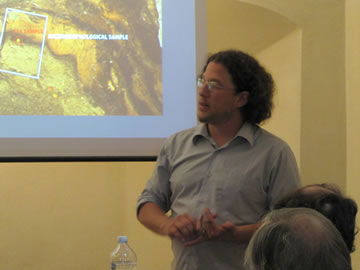|
Julien Riel-Salvatore is Assistant Professor in the Department of Anthropology at the University of Colorado Denver. He was born in Montréal, Canada, earning his BA (first class honors) from McGill University there before attending Arizona State University where he received his PhD in 2007. Following this, he was a Postdoctoral Fellow of the Social Sciences and Humanities Research Council of Canada for two years at McGill University, where he also lectured in the Department of Anthropology. In 2009, he moved to his current position at UC Denver, from where he continues his research on Neanderthals and the Paleolithic archaeology of Italy. His research focuses on Neanderthals and the earliest Homo sapiens settlement of Europe. He has conducted fieldwork in Spain, South Africa, Ethiopia and the US Southwest, but since 2003 his research has taken place mostly in Italy, a country whose distinctive geography makes it a unique archaeological laboratory to study larger processes, such as the disappearance of Neanderthals. His research showing that Neanderthals were able to innovate independently of Homo sapiens influence has recently been featured in the New York Times, the BBC and the Washington Post, in addition to being published in scientific journals including the Journal of Archaeological Method and Theory, Current Anthropology and American Antiquity. Since 2008, with several Italian colleagues, he has also been directing a large-scale international collaborative excavation project at the Caverna delle Arene Candide in northern Italy, where prehistoric art and early modern human levels have recently been identified. Every year, this ongoing project provides students and volunteers with the opportunity to experience archaeological research first-hand. He also blogs about his research and current news in archaeology and paleoanthropology at A Very Remote Period Indeed, part of his ongoing efforts to make research on human origins understandable and appealing to as wide an audience as possible. Julien lives in Denver with his wife Alejandra and their newborn son, Mateo. |

|
For decades scientists believed Neanderthals developed modern tools and ornaments solely through contact with Homo sapiens, but new research by anthropologist Julien Riel-Salvatore, PhD, challenge a half-century of conventional wisdom maintaining that Neanderthals were thick-skulled, primitive cavemen overrun and outcompeted by more advanced modern humans arriving in Europe from Africa.
|
